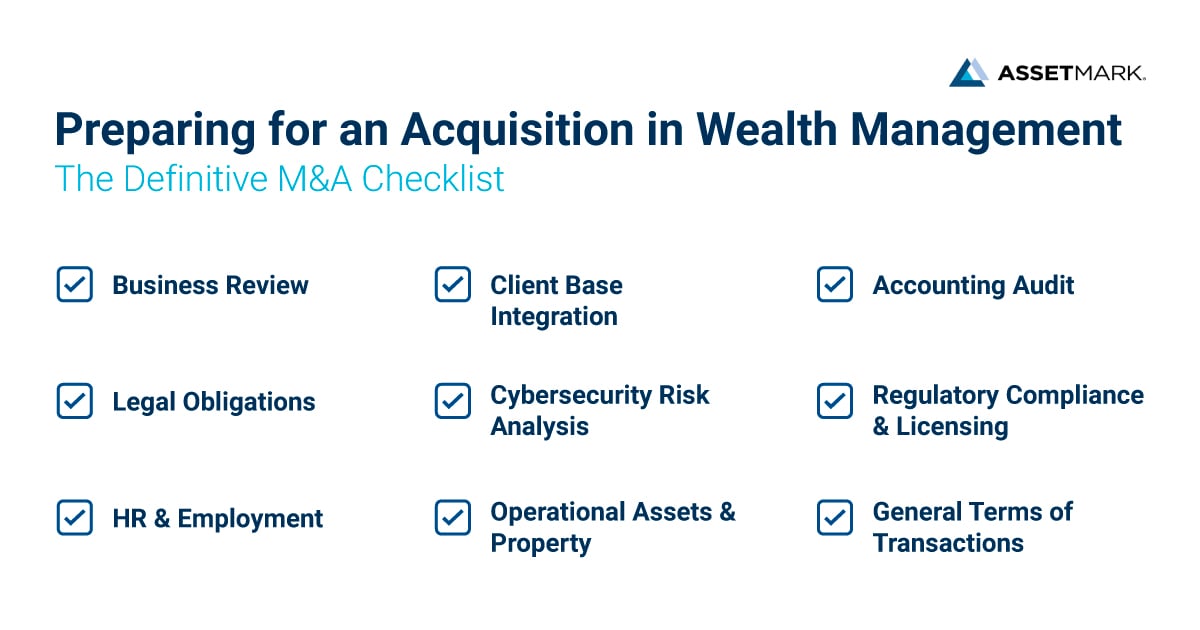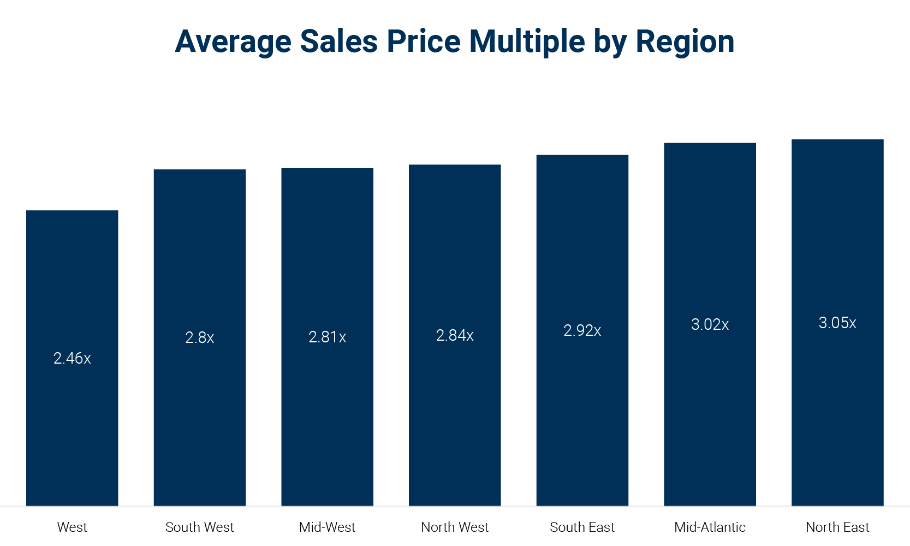Acquisitions in the financial services industry are guided by the search for value. Firms considering selling or merging their practice must be aware that today’s buyers are seeking ways to unlock future advantages by acquiring the ability to scale effectively. This trend persists in a still-fragmented marketplace where consolidation is increasing in velocity and changing the entire competitive landscape in the process.
Advisory firms that possess a distinct set of modern growth-driven capabilities and attributes will be particularly attractive acquisition targets going into 2023 and beyond. And for those looking to acquire, an attractive seller is a prepared one. This is an environment where getting ready for mergers and acquisitions (M&A) deals is not only a smart bet, but it’s also a strategic safeguard that helps ensure your firm is operating at full efficiency while displaying the optics most attractive to the biggest buyers in the market.
The following is a roadmap with the raw materials, perspectives, and insights needed to properly assess a potential sale, in addition to helping to position your firm as a compelling wealth management acquisition target. While we’ll focus primarily on the sell side, this expanded analysis of the M&A outlook and key stakeholder needs also provides critical information for those looking to execute a merger as well. This M&A guide will do three things to help:
The past decade has seen a huge perception shift around consolidation in the wealth management space, with 2022 being another banner year for M&A transactions and interest.
| 300+ Asset & Wealth Management Transactions over past 12 months PWC |
70% Survey respondents who explored acquisitions in 2022 Wealth Management IQ |
But how will 2023 stack up? Overall, analysts expect the deals to continue in 2023, albeit at a slower pace than the breakneck speed we saw in 2021 and 2022. But this is only expected in the first half of the year as a confluence of yet-to-be-resolved macroeconomic issues, such as the uncertain rate environment, inflation expectations, and the Ukraine War, will likely keep deal volume low over the short term. Once we have more clarity on these issues, it is likely deal flow will pick up in the second half.
So, rather than a cause for concern, a temporary slowdown can be considered an opportunity to optimize. Now is the time to understand what buyers are looking for, think deeply about your own rationale for selling, and take steps to upgrade your firm structure and strategy to get ahead of peers and create an attractive, value-added financial advisory industry acquisition target. Buy-side wealth managers and Private Equity firms are constantly surveilling the landscape, so if you wait around for more certainty, the opportunities might end up passing you by.
“As more companies use M&A to build scale economics and acquire today’s capabilities that will become tomorrow’s table stakes, those that sit on the sidelines are likely to end up staying there.”
-Bain & Company
In the following section, we’ll identify and explore the key acquisition considerations that firms must keep in mind to position themselves favorably for what is looking like a pickup in deals in the second half of 2023.
To have the most effective perspective going into an acquisition, you need to acknowledge and factor in the various viewpoints of those involved. As the seller, viewing the situation through not only your lens but the buyer's lens as well will allow you to prioritize key considerations and position your firm as a true value-add.
39%
Identifying a suitable partner is the top barrier to acquisition
DeVoe 2022 RIA M&A Outlook Study
But always keep in mind that this is decidedly not just a two-party transaction. Financial services is also a relationship business, and we cannot ignore the most important stakeholder in all of this: the client. A comprehensive three-sided perspective will allow for a complete view of the deal dynamics, which should translate into a seamless, low-conflict transaction where all stakeholders’ interests are accounted for in good faith. Here are the most important stakeholder perspectives and considerations when assessing an acquisition:
Buyers are looking for value. They want to make their firm more efficient, more capable, and more impactful. They want to increase competitive advantage by growing proactively and intelligently.
Modern buyers have a distinct set of needs when considering acquisition targets, with the most important related to growth in its various forms. The following ranked list is based on responses to a buyer priority survey by DeVoe & Company:
Sellers want certainty. Firms looking to sell want a solid plan related to a full exit or organizational integration. They want a buyer who is also a partner that can take what made the firm unique in the market and integrate those value drivers into the acquiring firm’s organizational structure in a seamless and healthy way.
For sellers, the value of a deal might not be growth-related at all, but rather more focused on fit and succession considerations.
1 in 4
Advisors unsure of succession plan
Cerulli Associates
On the other side of the coin, are you a young firm looking to take the next step towards growth? Attract an established buyer interested in bringing on up-and-coming talent who can lead their firm once the aging principles retire. Considering the age breakdown of the wealth management industry, this could be a sound strategy.
| 57 Average age of wealth advisor |
11% Advisors below 40 |
70% 20% Advisors over 65 |
J.D. Power 2019 Financial Advisor Satisfaction Study
Clients demand strong relationships, service, and support. If the deal does not consider these keys, then an acquisition or merger may not be in your best interest as a firm. A service-oriented industry must consider the end client, or the business model will fail to reach full value. The primary focus here is on front-facing technology and personnel, so make sure to look at client impact closely:

Equipped with the proper perspectives, you can now start focusing on what is specifically needed to be prepared for being acquired. Here is an acquisition checklist to ensure sellers have everything necessary for a successful transaction:
Before looking at specific ways to position your firm to maximize its value in the marketplace, it’s important to identify the methods with which buyers are utilizing to evaluate potential acquisitions.
This tends to revolve around three valuation approaches:
For reference, here are revenue multiples breakdowns by both firm size and region:

Source: 2022 Advisor M&A Review: Current Data and Trends for Financial Service Professionals
With an understanding of the financial due diligence undertaken by the acquiring firm, we can look at a few ways to enhance value through both upgrades and optics:
To learn more about enhancing your value as a firm, starting with your value proposition, read How to Deliver a Value Proposition That Drives Business Growth
Knowing how to approach the buyer-seller dynamics of an acquisition in wealth management is paramount in ensuring a clean and secure process for all stakeholders. The following details two distinct examples of financial advisory M&A best practices.
Mergers & acquisitions are highly charged processes that require mental fortitude, constant analysis, and true professionalism. This makes communication, honesty, and accuracy all imperative when undertaking the challenge.
So, if there was one word that brings all that collaboration and information together, it would be: transparency.
Clearly conveying objectives, financial disclosures, operational strategies and potential pitfalls will only improve the results, either by optimizing the deal to reach its maximum value or uncovering deal-breaking issues that could sink the process.
Preparing for M&A requires quite a bit of information and data transfer, and with cybersecurity risks involved, having a secure data room can be a huge time and cost-saving benefit to the process. Essentially a digital warehouse of key documents, these data rooms should include:
A data room not only helps preserve confidentiality but also provides that key variable today’s buyers are seeking: a responsible partner.
There are few industries with more attractive M&A potential than wealth management, a fragmented space where performance, process, and personnel need to operate at their optimum at all times. This makes preparation for acquisition a prime consideration for all sizes and types of financial advisory firms, not only to help position optimally amongst your peers, but also to ensure your organization runs efficiently while signaling positive optics to buyers in the process.
AssetMark understands the complexity and value of intelligent assessment and preparation for a wealth management acquisition and is here to provide the resources and trusted support to ensure your firm understands its value and is positioned favorably in the wealth management marketplace.
AssetMark is a leading provider of extensive wealth management and technology solutions that help financial advisors meet the ever-changing needs of their clients and businesses.
Subscribe to get a monthly recap of AssetMark blog articles.
AssetMark is a leading provider of extensive wealth management and technology solutions that help financial advisors meet the ever-changing needs of their clients and businesses. The information on this website is for informational purposes only and is intended as an overview of the services offered to financial advisors, not a solicitation for investment. Information has been drawn from sources believed to be reliable, but its accuracy is not guaranteed and is subject to change.
Advisors seeking more information about AssetMark’s services should contact us; individual investors should consult with their financial advisor.
AssetMark, Inc. is an investment adviser registered with the U.S. Securities and Exchange Commission. Visit our ownership page for more information.
© 2025 Copyright AssetMark, Inc. All rights reserved. 6916884.1 | 02/2025